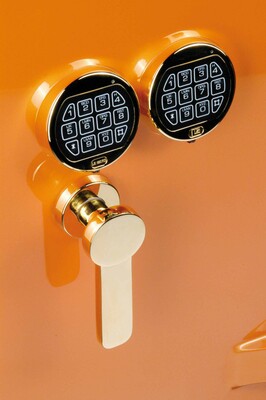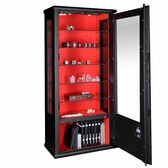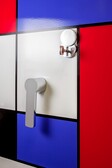Did you know that choosing the type, model and resistance class of a safe is not everything? Anyone who decides to effectively secure their property and valuables must also consider the choice of a lock for the safe. This is not so easy, because on the market you will find many different types and models, which have different resistance classes. However, the most important point is to purchase a certified security device. From this article you will learn what are the advantages and disadvantages of an electronic lock, what is its principle of operation, who should consider choosing such security and how to operate it.
Functioning principle of an electronic lock for a safe
Electronic lock is not quite the correct term. In fact, it is an electromechanical lock. It combines the principle of a traditional mechanical lock with an electric drive and the ability to open using a numeric keypad, a fingerprint or even remotely with a smartphone.
The principle of an electronic safe lock is simple. The security device in the door gets a signal from an electronic reader or keypad and opens the lock. If the code is entered incorrectly or the wrong finger is scanned on the biometric reader, the system will not open the lock.
Is an electronic lock for a safe secure?
Not every electronic lock is safe. A lot depends on the quality of its workmanship and above all its security class. Certified electronic security is a safe solution. On the other hand, a budget safe electronic lock without a security class offers practically no guarantee of protection.
Much depends on how the safe is opened. An electronic lock with a numeric keypad is less secure than one with a fingerprint reader. In the case of a code, there is a risk that someone will surreptitiously suspect the moment of entering the code and remember the password. If a biometric reader is fitted, there is no such risk.
However, an electronic lock for a safe opened with a fingerprint is not ideal. First of all, it will not work for people who are prone to cuts. Moreover, if you play stringed instruments or deal with chemicals, your fingerprints may be blurred and the reader will not recognise them. People with sweaty palms or who often work with grease (e.g. mechanics) should also forego this protection.
Find out how to open a safe without a battery and what to do in case of failure?
How do I code an electronic lock for a safe?
Electronic safe locks are fairly simple to code. However, keep in mind that the procedure for assigning the code may vary from model to model. Before you code the lock, carefully read the instruction manual.
An electronic safe lock equipped with a numeric keypad has a factory coded code (usually 123456 or 111111). To enter the new code, open the door (always change the password with the door open). The next step is to press the asterisk (*) and confirm with enter. Then press the number 1 and also confirm with the enter key. Now enter the factory code, confirm again with enter and enter the new code, which must also be confirmed with enter. The device may ask you to confirm the new code.
Coding a lock equipped with a fingerprint reader is even simpler. Simply press the fingerprint installation button and place your finger on the reader. After hearing a beep you can repeat the operation and encode another fingerprint. A flashing red LED informs about an incorrect reading.
We recommend other articles, too:
What other safe locks to choose
If you're not convinced by electronic security, you can opt for key or mechanical safe locks with a traditional dial. They are just as easy to use and don't require batteries or mains power.
A mechanical lock with a knob is a high-security solution. The code is easily entered by a combination of several turns of the rotary dial. Unfortunately, the unscrewing of the code requires high precision. As a result, the opening time is much longer than with other security devices. People who have a problem with trembling hands should avoid this lock.
Key safe locks are a standard security feature. They are characterised by their simple design, easy operation and faultlessness. In this case, you don't have to remember the code and opening is instantaneous (unless you have forgotten, damaged or lost the key). Key safe locks are also the cheapest security, but you must have a secure place to store your keys.
Whether you choose key safe locks, mechanical or electronic, does not matter as much as the burglary resistance class. An electronic safe lock without a certificate will be far worse security than a key lock that meets European standards and has a high security class. Therefore, order a solid safe today with the most convenient security confirmed by a security certificate.





